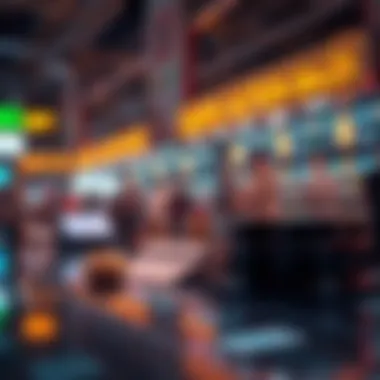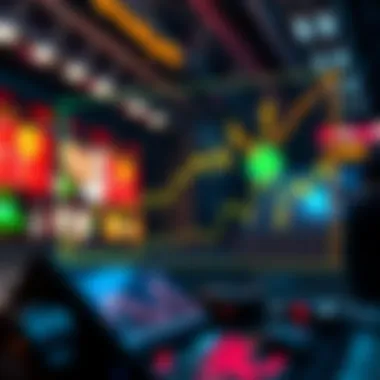Understanding NFT Auction Houses: Dynamics Explained


Intro
The realm of digital assets has exploded in recent years, drawing the attention of tech enthusiasts, investors, and art collectors alike. At the heart of this digital revolution are NFT auction houses. These platforms provide a unique marketplace where digital art can be bought, sold, and traded, often for staggering sums. As interest in non-fungible tokens (NFTs) continues to grow, understanding the intricacies of NFT auction houses becomes increasingly crucial for anyone involved in this fast-evolving landscape.
NFT auction houses not only reshape the way art is propagated and appreciated, but they also offer a novel method for creators to monetize their skills. The dynamics of these platforms compel artists to navigate a market flux that is as unpredictable as it is exciting.
In the following sections, we will dissect market trends, historical patterns, investment strategies, and their broader implications in the cryptocurrency ecosystem. By exploring these elements, we aim to furnish readers—whether they be traders, investors, or mere curious onlookers—with a well-rounded understanding of the auction house model within the context of NFTs.
Market Trends
Understanding market trends is essential when diving into NFT auction houses. The pulse of the market can determine not only the value of assets but also the sustainability of the platforms themselves.
Current Market Analysis
The current landscape of NFT auction houses is indicative of a burgeoning interest in digital assets. Leading platforms like OpenSea and Rarible have established themselves as major players, facilitating transactions that run into millions of dollars. Market analysis reveals several key trends. Firstly, the demographic of NFT buyers has broadened; it's not just tech-savvy millennials snapping up digital art anymore but also a diverse group that includes older investors and traditional art collectors seeking to diversify their portfolios.
Additionally, as the NFT market has matured, there is a noticeable shift toward more established artists. Buyers are increasingly focusing on provenance and the background of the creator, taking into consideration their prior work in both digital and physical formats. In a sense, the conversation around NFTs has shifted from just technology to broader artistic merit and recognition.
Historical Trends and Patterns
Looking back, the genesis of NFT auction houses can be traced back to the beginnings of blockchain technology. Early platforms were often seen as experimental, attracting niche audiences. However, major sales, like the infamous digital collage by Beeple selling for $69 million at a Christie's auction, acted as a flashpoint for mainstream acceptance.
In recent years, sales volume and number of transactions have sky-rocketed. Around 2021, a peak was observed, with months surpassing $1 billion in sales, although this led to a classic boom-and-bust cycle that is common in similar markets. According to market trends, fluctuations were somewhat expected due to speculation and hype surrounding NFTs, making thorough analysis of historical data vital for potential investors.
Investment Strategies
A primary concern for many entering this space is how to approach investment strategically. The volatile nature of NFTs requires careful contemplation, especially regarding long-term versus short-term investments and risk management techniques.
Long-Term vs Short-Term Investments
Investors must decide on their strategy based on risk tolerance and investment goals. Short-term strategies often revolve around flipping newly launched NFTs for quick gains. This approach can yield high returns but also comes with higher risks, especially when market conditions shift.
On the other hand, long-term investments stem from acquiring pieces by established artists or collections that show promise over time. This requires a different mindset, focusing on the underlying value of the NFT rather than solely its speculative price.
Risk Management Techniques
To mitigate risks, investors could consider several strategies:
- Diversification: Spreading investments across various NFT platforms and artists can cushion against losses.
- Market Research: Staying informed about market conditions and trends can help in making educated decisions.
- User Reviews: Engage with communities, such as those on reddit.com, to gauge perceptions and experiences around specific auction houses and artworks.
- Set Budgets: Like with any investment, setting and adhering to a budget can prevent potential financial strain.
"In the world of NFTs, knowledge is as valuable as the assets themselves. Educated investors are likely to fare better in the long term."
Understanding the mechanics of NFT auction houses, paired with a solid grasp of market trends and investment strategies, can provide invaluable insights for participants in this digital revolution. As we continue to explore this theme further, it becomes clear that while there are substantial risks involved, the opportunities presented are equally robust, making it an exciting time for both artists and collectors.
Prologue to NFT Auction Houses
The emergence of NFT auction houses marks a pivotal shift in the world of digital assets and art. As these platforms gain traction, understanding their functions becomes increasingly essential. They have revolutionized how artists sell their work and how collectors acquire digital pieces, intertwining financial speculation with artistic expression. This section lays the groundwork for exploring the intricate dynamics of these auction houses and reveals crucial aspects that will be unpacked in this article.
Defining NFTs and Auction Mechanics
NFTs, or non-fungible tokens, are unique digital identifiers stored on a blockchain—a technology lauded for its security and transparency. Unlike conventional cryptocurrencies, which are interchangeable, NFTs represent ownership of specific digital items, making them particularly appealing to artists and collectors in the digital realm. An NFT associated with a piece of art guarantees its authenticity and provenance, a crucial factor in a market often riddled with counterfeits.
When delving into auction mechanics, one must note that these houses don't operate like traditional art galleries. They usually employ various auction models, such as English auctions, in which bids ascend until one highest offer wins; or Dutch auctions, where the price drops until someone accepts it. It's also common to encounter mechanisms like reserve price auctions, where the seller sets a minimum price that must be met for the sale to proceed. Understanding these nuances can enrich appreciation for how these platforms create economic ecosystems around digital art.
Historical Context of Digital Art Sales
To appreciate the significance of NFT auction houses, one must consider the historical trajectory of digital art sales. In the late 20th century, artists began dabbling with digital mediums, yet their work often faced skepticism due to questions about originality and ownership. As technology advanced, so did the methods of digital distribution; platforms like DeviantArt and Etsy emerged, showing signs of a bustling marketplace. However, these platforms lacked the element of value that NFTs provide.
The rise of NFT auction houses in the early 2020s dramatically changed the landscape. Well-known platforms, such as OpenSea and Rarible, emerged, allowing creators to mint and sell their works as NFTs. A landmark moment was the $69 million sale of a digital collage by Beeple at Christie's, flinging digital art into the limelight and highlighting the potential for monumental sales.
In sum, NFT auction houses offer a meeting point for creativity and commerce, bridging the gap between artists and collectors in a way that was previously unimaginable. Their emergence is not merely a trend; it is rapidly becoming a foundational component of the modern art world, necessitating deeper exploration of their mechanics, risks, and implications.
Key Characteristics of NFT Auction Houses
NFT auction houses have become the go-to platforms for buying and selling non-fungible tokens, greatly altering the landscape for artists and collectors. Understanding these auction houses’ key characteristics is fundamental to navigating their dynamics and implications in the digital economy. They serve as not just transaction facilitators but also as crucial platforms influencing market trends, accessibility, and the valuation of digital assets. Each characteristic plays a part in defining how these houses shape the buying and selling process and, ultimately, the future of digital art.
Types of Auction Models
Different auction models characterize the way transactions are conducted within NFT auction houses. Each of these models has its unique benefits, influencing buyer behavior and seller strategies.


English Auction
The English auction is perhaps the most recognized type of auction model. Here, the bidding starts at a predetermined price and progressively increases as bidders raise their offers until no one else is willing to bid higher. This specific aspect accentuates competitive bidding, driving prices upward as participants outbid each other.
A key characteristic of the English auction lies in its transparency – bidders can observe the competing offers as they unfold. This encourages an atmosphere of rivalry, motivating participants to act when they see others are interested. For artists, it's a beneficial choice as it often results in higher sale prices driven by demand. However, this method can also lead to volatility, where late bids might throw off valuations.
Advantages:
- High potential for inflated prices due to competitive nature.
- Real-time visibility of bids encourages participation.
Disadvantages:
- Market volatility can lead to unpredictable outcomes.
Dutch Auction
In contrast, the Dutch auction flips the script. It typically starts with a high price, which gradually decreases until a buyer accepts the current price. This unique feature creates urgency because bidders must act quickly to secure the item before the price drops too low.
The main advantage of the Dutch auction model is its efficiency. It saves time, especially when there is high demand for an item. This method is particularly favored when an artist is selling multiple works or when a collector is eager to make a quick acquisition. However, it is less common in markets characterized by higher bidder engagement.
Advantages:
- Quick resolution and acquisition process.
- May capture spontaneous buyers looking for good deals.
Disadvantages:
- Can discourage some bidders who prefer a more traditional bidding atmosphere.
Reserve Price Auction
Lastly, the reserve price auction model sets a minimum price that must be met for the sale to proceed. If bidding doesn't reach this price, the item is not sold. This approach offers a safety net for sellers, ensuring that they do not sell their art at undervalued prices.
This specific aspect is particularly valuable to artists and collectors alike, as it prevents financial losses. It offers a level of security that may otherwise be absent in more open auction formats. However, the downside is that it might deter potential bidders who are unaware of the reserve price or find it too high, leading to missed opportunities.
Advantages:
- Safeguards the seller’s interests, ensuring fair valuations.
- Prevents undervaluation of valuable works.
Disadvantages:
- Potential for unsold items can be frustrating for sellers.
Platforms and Their Unique Features
Different platforms host these auction models, each bringing unique features to the table. Recognizing these differences equips artists and investors with the knowledge to choose their marketplace wisely.
OpenSea
OpenSea stands out as one of the largest NFT marketplaces. It boasts a wide array of digital assets, facilitating various auction models, including English and reserve price auctions. Its expansive reach makes it a popular choice among collectors looking for a diverse range of NFTs. OpenSea's user-friendly interface enhances the experience for both artists and buyers, decreasing barriers to entry.
However, the vast number of options can sometimes dilute visibility for new artists, making it essential to be strategic about listings.
Advantages:
- Broad selection and high traffic volume.
- Accessible for new artists and collectors.
Disadvantages:
- High competition can obscure visibility for emerging creators.
Rarible
Rarible empowers artists with the ability to create and sell NFTs directly. What sets Rarible apart is its built-in community governance. Users earn RARI tokens through their participation, influencing platform operations. This model appeals to the artist community as they feel a sense of ownership over the platform. It encourages active participation and further investment in the NFT ecosystem.
The downside is that, being community-governed, it may become susceptible to market trends driven by token holders rather than the art itself, which can confuse potential buyers.
Advantages:
- Enables direct artist sales and community involvement.
- Encourages a dynamic and responsive platform environment.
Disadvantages:


- Possible instability in governance decisions could impact user trust.
Foundation
Foundation is embraced for its curated approach, where artists are invited to join based on referrals, creating a sense of exclusivity that can enhance作品's value. It focuses on high-quality digital art and crafts a community feel, fostering deeper connections between artists and collectors.
The curated nature can also pose challenges, as not all artists have equal access, potentially limiting diversity on the platform. For collectors, it guarantees a level of quality but at the cost of missing out on emerging artists who might not have the network to gain entry.
Advantages:
- Curated quality ensures high-standard art.
- Strong community engagement among artists and collectors.
Disadvantages:
- Limited access for uninvited or new artists restricts marketplace diversity.
By understanding the distinct types of auction models and the unique features of each platform, participants in the NFT space navigate their options to make informed decisions. The dynamics at play in NFT auction houses are not just about selling digital art; they reflect broader trends in how art is valued and traded in a digital world.
The Role of NFT Auction Houses in the Digital Economy
NFT auction houses have become critical players in the digital economy, facilitating transactions that resonate with both artists and collectors. Their role stretches beyond merely acting as platforms for buying and selling digital assets. They shape the pathways through which digital art and collectibles are lauded or overlooked. By understanding their impact, one can appreciate not just the transactions involved but the broader economic implications.
Facilitating Artist Revenue Streams
One of the foremost benefits of NFT auction houses is their ability to provide artists with substantial revenue streams. Traditionally, artists often struggled to gain a fair share of profits from their work, especially in a market heavily dominated by galleries and traditional art institutions. However, NFT platforms have flipped the script, enabling creators to earn directly from their art sales without such intermediaries.
- Direct Sales: Artists can set their own prices, creating a more equitable distribution of income. This direct-to-consumer sales model is revolutionary; it allows artists to retain control over their work and its valuation.
- Royalties: Many NFT auction houses, like Rarible and Foundation, incorporate smart contracts that ensure artists receive a percentage of sales every time their artwork changes hands. This feature allows creators to profit not only on initial sales but continuously as their work gains value.
"This direct connection between artists and their audience fosters an environment ripe with creativity and innovation."
Yet, it’s not all smooth sailing. While the opportunity for revenue has increased, the volatile nature of the NFT market presents challenges. Artists need to navigate price fluctuations and demand dynamics, which can be unpredictable and, at times, disheartening.
Curatorial Practices and Artist Promotion
NFT auction houses also embrace curatorial practices that play a vital role in artist promotion. Unlike traditional galleries that often favor known names, NFT platforms offer a space where emerging artists can be recognized.
- Visibility and Exposure: Auction houses curate collections that highlight both established and up-and-coming artists. This increased visibility can lead to new networking opportunities and the potential for future collaborations. It also allows collectors to discover fresh talent, potentially fueling the next wave of digital art stars.
- Themed Auctions: Some platforms run themed auctions that align with trending topics or social movements. For instance, an auction centered on climate change might spotlight artists addressing environmental issues through their work. This creates a communal space where art serves a larger purpose.
However, the challenge lies in the saturation of the market. With countless artists vying for attention, not every talented creator will get their moment in the spotlight. Therefore, it becomes essential for platforms to strike a balance between inclusivity and quality control, ensuring that the narrative around digital art remains robust and engaging.
Links for further reading:
Market Dynamics of NFT Auctions
Market dynamics play a crucial role in shaping the landscape of NFT auctions, affecting everything from pricing to artist visibility. Understanding these dynamics is essential for traders, investors, analysts, and tech enthusiasts who wish to navigate this ever-evolving digital frontier effectively. Key elements like price determinants, liquidity, and scarcity will influence how NFTs are perceived and traded. Grasping these factors not only helps in making informed decisions but also enhances the appreciation of the digital art ecosystem as a whole.
Price Determinants in NFT Auctions
Several factors come into play when determining the price of NFTs during auctions. These range from intrinsic qualities like the artwork's uniqueness to broader market conditions. Here are crucial elements that dictate pricing:
- Artist Reputation: Established artists typically command higher prices due to their history and follower base.
- Rarity: Limited editions or one-of-a-kind pieces often attract higher bids.
- Market Trends: A surge in interest around a specific genre can spike prices accordingly.
- Historical Sales Data: Previous sales of similar NFTs can set benchmarks for future auctions.
- Utilities Attached: If an NFT possesses additional utilities, such as exclusive access to events or digital landscapes, it can dramatically influence its price.
These determinative factors interact dynamically, creating a complex web that potential buyers and sellers must navigate.
The Impact of Liquidity and Scarcity
Liquidity and scarcity are pivotal in dictating the functioning of NFT markets. Liquidity refers to how quickly an asset can be bought or sold without affecting its price significantly. High liquidity in NFT auctions can lead to:
- More Active Trading: Sellers find it easier to liquidate their assets, encouraging more participants in the market.
- Stable Prices: Increased buyer interest tends to stabilize prices as demand meets supply.
On the other hand, scarcity can cultivate a sense of exclusivity that drives prices upwards. When NFTs are perceived as scarce, it can lead to:
- Feverish Demand: Potential buyers may feel compelled to act quickly—resulting in bidding wars.
- Increased Value Perception: The psychological impact of scarcity can make an NFT seem more valuable, regardless of intrinsic qualities.
Understanding how liquidity and scarcity interact provide the context for informed bidding strategies and investment decisions in the NFT ecosystem. Each trait holds significant implications for both individual sales and overall market trends.
"In the ever-shifting sands of the NFT market, grasping liquidity and scarcity is akin to holding a compass for a trader—they guide us through uncertainty."


The examination of these market dynamics continues to highlight the importance of a strategic approach when engaging with NFT auctions. By closely monitoring these elements, traders can carve their niche within this budding ecosystem.
For further reading and a richer understanding of broader economic implications, consider exploring resources such as Investopedia, project-syndicate.org, and NPR.org for updates on market trends.
Evaluating the Risks of NFT Auctions
When diving into NFT auctions, one must not overlook the inherent risks that come along with the excitement of participating in this digital marketplace. Understanding these risks is integral for traders, investors, and collectors alike, as it allows for better decision-making and strategic planning when navigating this relatively new domain. The volatility of the NFT market, paired with challenges in ownership verification, can significantly impact the perceived value and authenticity of digital assets. These elements warrant thorough examination to properly grasp the environment surrounding NFT auction houses.
Volatility in the NFT Market
The NFT market is notoriously volatile. It can feel like a roller coaster ride: one moment you're at the peak, and the next, you could be plunging into a steep decline. Prices for NFTs often swing widely within a short timeframe, influenced by trends, hype, celebrity endorsements, and even social media chatter. This eratic nature makes it crucial for participants to remain vigilant and aware of market movements.
"In the world of NFTs, a tweet can send prices soaring or crashing faster than you can say blockchain."
Consider these factors that contribute to market volatility:
- Speculation: Many buyers are speculating rather than investing based on intrinsic value, contributing to price spikes and drops.
- Seasonality: Like other markets, NFT prices can exhibit seasonal trends, with peaks during major sales or events.
- Demand and Supply: Limited editions often ignite bidding wars, leading to rapid price increases. However, if interest wanes, those prices can plummet.
It's essential for anyone involved to not only focus on potential gains but also to prepare for the possibility of significant losses.
Challenges Related to Ownership Verification
Ownership verification in the realm of NFTs can be rather murky. While blockchain technology offers a method for verifying ownership, complications still arise, creating hurdles for buyers and sellers. The lack of standardization across various platforms can lead to confusion about the provenance and authenticity of digital assets.
Some challenges include:
- Duplicate NFTs: Certain artists might release multiple copies of the same work, leading to disputes about which version holds more value or authenticity.
- Forgeries: As NFT art gains popularity, counterfeit works can infiltrate the market, making it hard for buyers to ascertain the genuine from the fake.
- Smart Contract Complexity: Buyers often struggle to understand the smart contracts related to NFTs, which could contain terms that affect ownership rights over time.
As the landscape continues to evolve, it is vital for participants to conduct thorough research and utilize tools designed to authenticate NFTs before engaging in transactions. By staying informed and cautious, investors can navigate this complex terrain with greater assurance.
The Future of NFT Auction Houses
The realm of NFT auction houses is on the verge of transformation. As artists, collectors, and investors scramble to understand this fast-evolving space, it's crucial to explore what the future holds for these platforms. This section will discuss technological advancements, market dynamics, and the potential that lies ahead for NFT auction houses, shaping not just digital art but the broader landscape of asset ownership.
Technological Innovations on the Horizon
The future of NFT auction houses hinges on a variety of technological innovations that can enhance user experience and democratize access to digital art. For instance, blockchain technology continues to evolve at a breakneck pace. New protocols promise improved scalability, which will allow auction houses to process numerous transactions with greater speed and lower fees. This could lead to a surge in user participation and further bolster the market.
Moreover, smart contracts are becoming more sophisticated. They can automate many aspects of the auction process, such as enforcing royalties for artists with each resale. Imagine a scenario where an artist can receive a percentage of every future sale of their work with no middleman involved - this might soon be commonplace.
Additionally, the integration of virtual reality (VR) and augmented reality (AR) within auction platforms can create immersive experiences for collectors. This not only enhances the aesthetic appreciation of digital art but also helps buyers visualize how pieces might interact with their existing collections.
To sum up, developments in technology are not just mere enhancements—they are set to redefine how we buy, sell, and interact with digital art in auction settings.
Projected Market Trends and Predictions
Analyzing the trajectory of NFT auction houses gives insights into possible market trends that may unfold. One key prediction is a shift towards niche auction platforms that specialize in specific genres of digital art. For instance, we might see auction houses that focus solely on generative art or those that cater exclusively to emerging artists. By narrowing the focus, these platforms can cultivate dedicated communities, encourage more tailored curation, and ultimately drive higher engagement and sales.
Another trend likely to gain traction is the convergence of physical and digital art markets. Collectors are beginning to see value in hybrid models where digital proofs of ownership complement tangible works. This dual approach not only appeals to diverse collectors but also enhances visibility into the digital realm.
Furthermore, as regulatory frameworks surrounding NFTs become clearer, mainstream investors may feel more secure entering the space. With more robust guidelines, larger financial institutions could start integrating NFTs into their asset portfolios, expanding the market dramatically.
"The evolution of NFT auction houses is as much a reflection of technological strides as it is of cultural shifts. Understanding this dynamic is crucial for anyone involved in the space."
The End
As we wrap up our exploration of NFT auction houses, it becomes evident that these platforms are not just niche markets but pivotal components of the burgeoning digital economy. The importance of understanding the dynamics of NFT auction houses lies in the multifaceted implications they carry for artists, collectors, and the broader market landscape. The rapidly evolving nature of these marketplaces can significantly influence investment strategies, artistic promotion, and ownership practices in the digital art realm.
Summary of Key Findings
Throughout this article, we have uncovered several crucial aspects of NFT auction houses:
- Diverse Auction Models: We examined the various auction formats—English, Dutch, and Reserve Price—each presenting unique mechanisms and strategies for sellers and bidders.
- Variety of Platforms: Different platforms like OpenSea, Rarible, and Foundation provide distinct features, shaping how users interact with NFTs and what they expect from auction experiences.
- Economic Significance: These auction houses play a crucial role in facilitating artists’ revenue streams, enabling creators to monetize digital work more efficiently than traditional frameworks.
- Market Dynamics: Factors like liquidity, scarcity, and market volatility directly influence pricing and bidding behavior, demanding that participants stay alert and informed.
- Risks Involved: The volatility inherent in this ecosystem poses significant risks, including fluctuating values and authenticity concerns, necessitating a thorough understanding before engaging.
Final Thoughts on NFT Auction Ecosystem
The landscape of NFT auction houses is a reflection of the technological advancements and societal shifts affecting digital ownership and creativity. Looking ahead, it’s crucial to remain observant of how these platforms evolve and the potential changes in regulations that could impact the gaming field, digital art collection, and investment in non-fungible tokens.
For anyone navigating this space—be it traders, collectors, or analysts—the insights gained from understanding NFT auction dynamics are indispensable. They empower individuals to make informed decisions and seize opportunities in this intricate and rapidly progressing domain.
To sum it up, as the NFT auction ecosystem evolves, it beckons us to consider broader implications beyond mere ownership. Are we ready to grapple with the consequences of digital value creation in our hyper-connected world? The conversation has just begun.
"In the end, it’s not just about the art, but how we value, appreciate, and engage with it in a world that’s increasingly more digital than physical."
For further reading on related topics, feel free to check out resources from Wikipedia, Britannica, or community discussions over on Reddit.
Stay informed, and may your journey through the NFT auction house landscape be both enlightening and rewarding.















